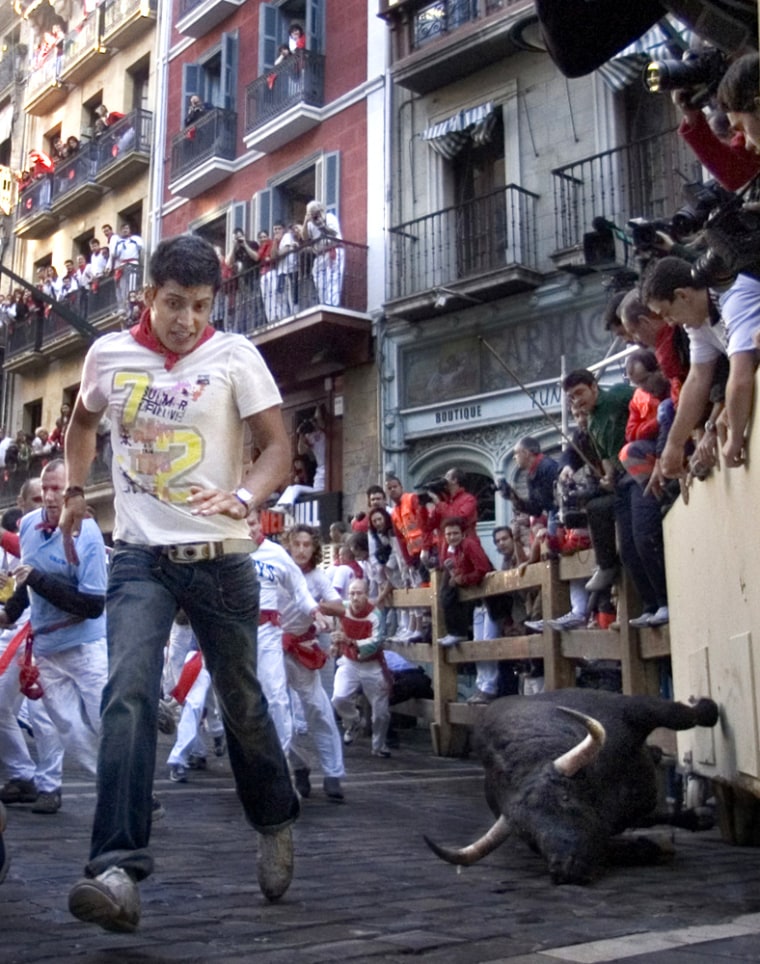A great number of stories have formed behind the parapet of Pamplona’s fortress walls. The city’s fiesta of San Fermin, which takes place every summer from July 6th, to July 14th, spins its intoxicating affect on those who attend and return again and again.
Many are familiar with Jake Barnes’ story in Ernest Hemingway’s "The Sun Also Rises", fewer perhaps of the six, wandering soul-searchers in James Michener’s "The Drifters". My parents have played the role — adorned in the fiesta’s native costume of white and red — and I look forward to hearing chapters from my Uncle Charlie’s annual stories after he returns home, still glowing from the nine days spent in abandon.
If I were to tell you the story of my San Fermin, it would not include early-morning encierros, gritty red wine, or death in the afternoon. Having attended my first fiesta at eleven months old and having experienced a total of nine fiestas before the age of fifteen, my story would be of rides on the ferris wheel, paper cones stuffed with greasy churros, skies dripping with colorful explosions, and Giants whirling over cobblestone streets.
Each time I returned anticipating these novelties, but really, I was brought back by the resolve of my parents and my uncle who had their own, personal reasons for returning every 6th of July — at my age, reasons I couldn’t quite understand but they wanted exposed to me all the same.
In August, I will be nineteen. Although my parents have not recently found the time to return to Pamplona, this year I have chosen to attend fiesta in hopes of writing a new chapter in my own story, or perhaps of discovering new meaning to stories I already know exist.
What makes San Fermin so exceptional is its ability to be both intensely personal and gratifyingly communal. The distinctly unique experiences of every individual make each fiesta different and it is the ability of the individuals to together make it so that it unites them all. If the person has truly immersed himself in the celebration—i.e. relinquished himself to jubilance—he will become an appendage of the San Fermin machine—unique in his role, but a contributing member of something much greater than he.
Although the fiesta has gained fame because of the dramatic down the old town’s narrow streets. It is easy to miss them. Sleep in late, or don’t purchase the often-pricey corrida tickets, and the only place you will see a bull during fiesta is splashed across T-shirts and posters or stirred into a thick stew.
But for many, seeing the bulls thunder up Santo Domingo and down Calle Estefeta every morning at eight a.m. is a sacred and essential part of their fiesta. Spectators line the barricades, fill balconies, duck into windowsills, stand on street lights, on boxes, on shoulders, insert themselves into any empty space and assume any necessary posture in order to see the six massive fighting bulls and their accompanying steers make their way through the hundreds of frenetic men who would rather play the game than watch from the sidelines. Even the flowers, nestled in their window beds, seem to lean their multicolored heads down to watch the run.
Each new day erupts with the shot of a gun, the slam of corral gates and the unequivocal battering of scores of hooves against Pamplona’s cobblestones streets. The unyielding sound of those hooves echo long after the bulls have made their way into the ring, penetrating your gut and boosting the tempo of your heart. Death’s palpability during the estefeda reminds fiesta-goers of life’s transience, laying the foundation for San Fermin’s mainfesto: to live life to the fullest. Although this is not the party’s official mission statement it is something each and every person holds in their heart and carries out in their actions during those nine radiant days.
Stepping into San Fermin is like stepping off of the universe. It is leisure without lethargy. It is a dream without illusion. And yet, San Fermin is something you will only understand if you go, and experience it for yourself.
